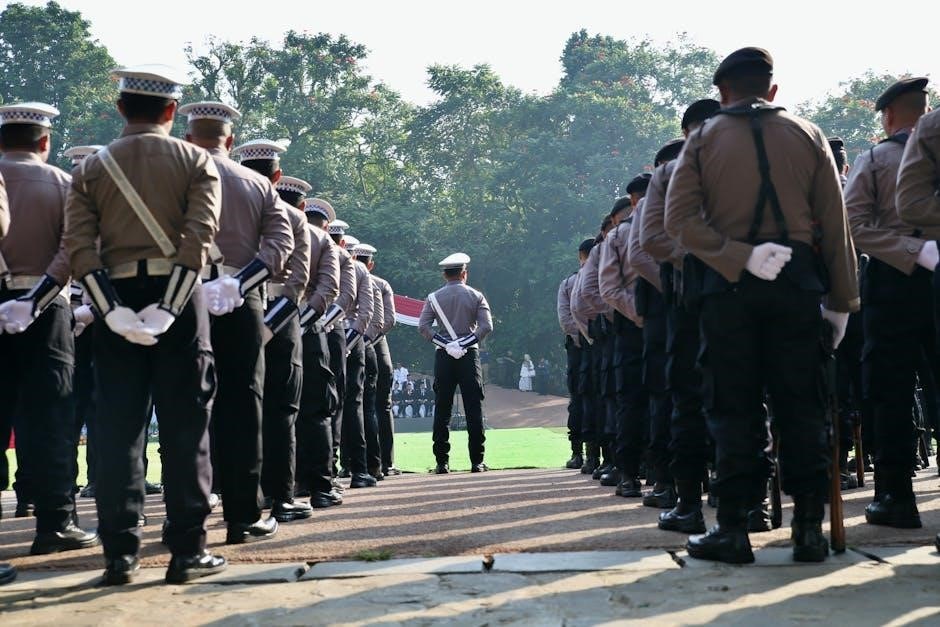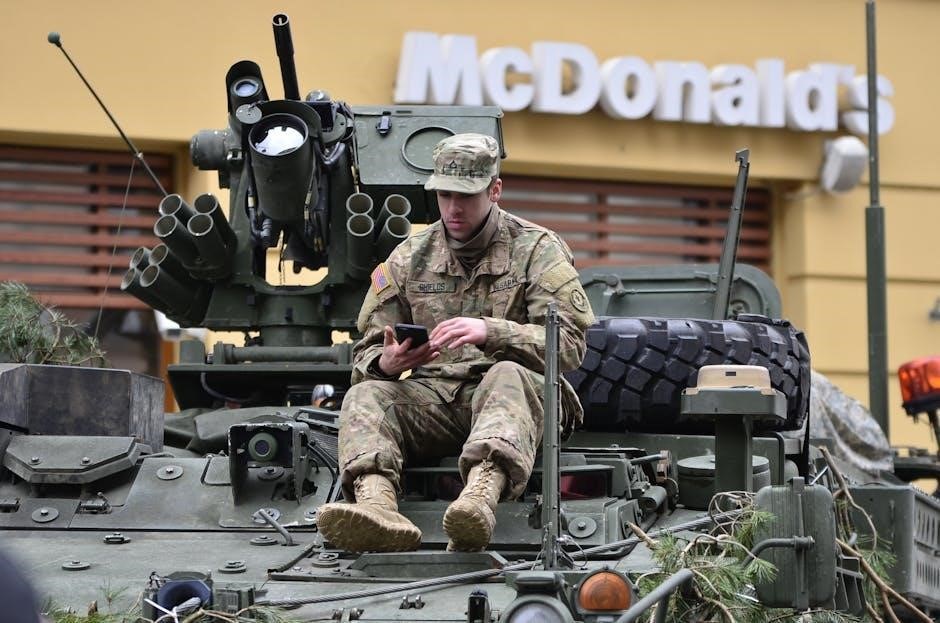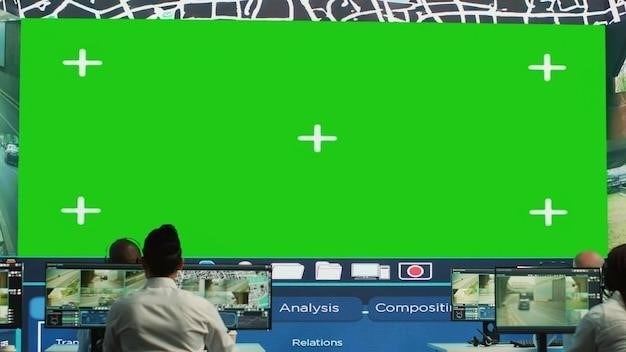The Security Classification Guide (SCG) provides a framework for classifying national security information․ It ensures proper handling and protection of sensitive data, including CPL Rice’s role․
1․1 Overview of the SCG
The Security Classification Guide (SCG) is a critical framework for classifying and managing national security information․ It ensures the proper handling and protection of sensitive data, such as details about CPL Rice’s role in military operations․ The SCG outlines classification levels, including Unclassified (U), Confidential (C), Secret (S), and Top Secret (TS), providing clear guidelines for safeguarding information․ This guide is essential for maintaining operational security and preventing unauthorized disclosure․ By adhering to the SCG, personnel ensure compliance with national security standards, protecting both individual roles and broader strategic operations․
1․2 Purpose of the SCG in National Security
The SCG’s primary purpose is to protect national security by ensuring sensitive information is appropriately classified and safeguarded․ It provides clear guidelines to prevent unauthorized disclosure, maintaining operational security․ The SCG helps identify classification levels, such as Confidential for CPL Rice’s role, ensuring information is accessible only to authorized personnel․ This framework supports strategic decision-making and protects critical data from potential threats, thereby upholding national interests and military effectiveness․ By standardizing classification practices, the SCG strengthens overall security infrastructure, ensuring the integrity of sensitive information․
1․3 Key Principles of Classification
The SCG operates on key principles ensuring information is classified accurately and consistently․ Classification is based on the potential harm to national security if disclosed․ The principle of “need-to-know” restricts access to authorized personnel only․ Information is classified to the lowest necessary level, avoiding overclassification․ Derivative classification ensures new documents rely on authorized sources․ Declassification occurs when sensitivity diminishes․ These principles ensure transparency, accountability, and efficiency in safeguarding sensitive data․ They guide classifiers like CPL Rice to balance security with operational needs, maintaining confidentiality where essential and sharing information responsibly when required․

Classification Levels as per the SCG
The SCG defines classification levels as Unclassified (U), Confidential (C), Secret (S), and Top Secret (TS)․ These levels ensure information is protected based on its sensitivity․
2․1 Unclassified (U)
Unclassified (U) is the lowest classification level under the SCG, indicating information that does not require protection․ It is publicly accessible and can be widely disseminated without restrictions․ Information classified as U is not sensitive and does not jeopardize national security․ For example, the SCG states that CPL Rice’s joint exercise start date, 1 May, is Unclassified․ This level ensures transparency and efficiency in sharing non-sensitive data while adhering to security protocols․ Proper handling of U information is straightforward, requiring no special measures beyond general good practices for data management․
2․2 Confidential (C)
Confidential (C) is the first level of classified information under the SCG, requiring protection against unauthorized access․ Disclosure could cause damage to national security․ CPL Rice’s role in joint exercises is classified as Confidential, indicating sensitive information that must be safeguarded․ Access is restricted to authorized personnel with a need-to-know clearance․ Proper handling and storage are essential to prevent unauthorized disclosure․ This classification ensures that sensitive operations remain secure while allowing necessary sharing among cleared individuals․ Adhering to these guidelines is critical to maintaining operational security and protecting national interests․ The SCG emphasizes the importance of strict adherence to Confidential classification protocols․
2․3 Secret (S)
Secret (S) classification protects information whose unauthorized disclosure could cause serious damage to national security․ Under the SCG, CPL Rice’s specific mission parameters and operational details are classified as Secret․ This level requires stringent access controls, ensuring only authorized personnel with a need-to-know and appropriate clearance can access the information․ The Secret classification is critical for safeguarding sensitive operations and preventing adversaries from gaining actionable intelligence․ Misuse or unauthorized disclosure of Secret information can lead to severe consequences, including compromised operations and national security risks․ Proper handling and storage are essential to maintaining the integrity of Secret-classified data․ The SCG underscores the importance of strict adherence to Secret classification protocols to protect national interests and ensure operational security․
2․4 Top Secret (TS)
Top Secret (TS) classification is reserved for information whose unauthorized disclosure could cause exceptionally grave damage to national security․ Under the SCG, CPL Rice’s involvement in certain high-level operations may require TS classification․ This level mandates the highest security measures, including specialized storage and transmission protocols․ Access is strictly limited to authorized personnel with a valid need-to-know and appropriate clearance․ TS information is often compartmentalized to further reduce exposure risk․ The SCG emphasizes that TS classification is only applied when lesser classifications are insufficient to protect the information․ Unauthorized disclosure of TS information can lead to catastrophic consequences, making strict adherence to protocols paramount for safeguarding national security․

Specific Classification Details for CPL Rice

The SCG specifies that CPL Rice’s role and activities are classified under specific guidelines․ His involvement in joint exercises is categorized as Confidential (C) or Secret (S), ensuring operational security․
3․1 Identification of CPL Rice in the SCG
The SCG clearly identifies CPL Rice as a key individual in classified operations․ His role in joint exercises is specifically highlighted, with activities classified under Confidential (C) or Secret (S) levels․ This classification ensures operational security and protects sensitive information related to his involvement․ The guide outlines specific details about his responsibilities and the reasoning behind his classification level, ensuring compliance with national security protocols․ Proper identification and classification of CPL Rice’s role are essential for maintaining the integrity of military operations and safeguarding sensitive data․
3․2 Classification of CPL Rice’s Role in Joint Exercises
CPL Rice’s role in joint exercises is classified under the SCG to ensure operational security․ His activities are designated as Confidential (C) or Secret (S), depending on the sensitivity of the operation․ The classification ensures that critical details about his involvement remain protected from unauthorized access․ The SCG specifies that the length of training exercises is classified as Confidential, while specific dates are categorized as Secret․ This structured approach maintains the integrity of military operations and prevents potential breaches of national security․ Proper classification of CPL Rice’s role is vital for safeguarding sensitive information and upholding the principles of the SCG․
3․3 Specific Information Classified as Confidential (C)
Under the SCG, specific information related to CPL Rice is classified as Confidential (C)․ This includes details about the duration of training exercises and certain aspects of his role in joint operations․ The classification ensures that sensitive information, which could compromise operational security if disclosed, is protected․ Confidential classification applies to data that requires controlled access to prevent unauthorized exposure․ This level of classification is essential for maintaining the integrity of military operations and ensuring that only authorized personnel have access to critical information․ The SCG clearly outlines the parameters for Confidential classification to safeguard national security interests effectively․

Training Exercises and Classification
Training exercises involving CPL Rice are classified based on their sensitivity․ Exercise lengths are marked Confidential, while specific dates are classified Secret to ensure operational security․
4․1 Length of Training Exercises Classified as Confidential
The Security Classification Guide (SCG) designates the duration of training exercises involving CPL Rice as Confidential․ This classification ensures operational security by preventing adversaries from anticipating timelines․ Specific details about exercise lengths are restricted to authorized personnel, balancing transparency with national security needs․ The SCG emphasizes that such classifications protect sensitive planning and execution phases, safeguarding military operations from potential threats․ By maintaining confidentiality, the integrity of training exercises is preserved, ensuring preparedness without compromising strategic advantages․ This approach aligns with broader national security objectives, underscoring the importance of classified information in military operations․ The SCG thus plays a critical role in securing these exercises effectively․
4․2 Dates of Training Exercises Classified as Secret
The SCG classifies the dates of training exercises involving CPL Rice as Secret․ This designation reflects the sensitivity of timing in military operations․ Revealing such dates could compromise operational security, making it vulnerable to adversarial planning․ The Secret classification ensures only authorized personnel access this information, safeguarding the element of surprise․ CPL Rice’s participation in these exercises further necessitates stringent security measures․ By maintaining secrecy around dates, the SCG protects national security interests and prevents potential threats from exploiting timing details․ This classification underscores the critical importance of confidentiality in preserving operational integrity and strategic advantages․ The SCG thereby ensures the security of sensitive schedules effectively․
4․3 Importance of Secrecy in Military Operations
Secrecy in military operations is paramount to ensure strategic advantage and protect lives․ The SCG emphasizes that unauthorized disclosure of classified information can compromise operations and endanger personnel․ For CPL Rice, maintaining secrecy is crucial, as it prevents adversaries from anticipating military actions․ Revealing sensitive details about exercises or missions could lead to counter-planning by hostile forces, undermining operational effectiveness․ The SCG’s classification framework ensures that only authorized individuals access critical information, safeguarding national security and preserving tactical integrity․ Secrecy is not just a protocol—it is a necessity for mission success and the safety of those involved․ Its importance cannot be overstated․

Handling and Sharing Classified Information
Classified information must be stored securely and shared only with authorized personnel․ Proper handling ensures national security and prevents unauthorized disclosure, protecting sensitive data effectively always․
5․1 Authorized Personnel Only
Access to classified information is restricted to authorized personnel with a legitimate need-to-know․ This ensures that sensitive data, such as CPL Rice’s role in joint exercises, remains secure․
Only individuals with proper clearance and authorization may handle or share classified materials․ Unauthorized disclosure can lead to severe consequences, including legal action and compromised national security․
5․2 Proper Storage and Transmission of Classified Data
Classified information, such as CPL Rice’s role in joint exercises, must be stored and transmitted securely․ This includes using encrypted systems and secure communication channels to prevent unauthorized access․
Physical documents should be kept in locked, access-controlled facilities, while digital files must be stored on approved, encrypted servers․ Transmission requires secure protocols, such as encrypted emails or secure messaging platforms, to safeguard data during transfer․
Adhering to these measures ensures the integrity and confidentiality of sensitive information, protecting national security and preventing potential breaches․
5․3 Consequences of Unauthorized Disclosure
Unauthorized disclosure of classified information, such as CPL Rice’s role, can lead to severe legal and national security consequences․ Personnel may face criminal charges, fines, and imprisonment under federal laws․
Professional repercussions include loss of security clearance, termination, and damage to career prospects․ Such breaches also jeopardize operational security, potentially endangering missions and personnel․
Civil penalties and mandatory training may follow․ Unauthorized disclosure undermines trust and compromises national interests, emphasizing the critical need for adherence to SCG guidelines․

Derivative Classification and Its Role
Derivative classification involves creating new documents using classified information, ensuring proper marking and protection․ It relies on authorized sources to maintain security standards and compliance with SCG guidelines․
6;1 Definition of Derivative Classification
Derivative classification refers to the process of assigning classification levels to new documents created from existing classified information․ It ensures that the new material maintains the same security level as the original source․ This method relies on authorized classification guides, such as the SCG, to determine the appropriate level of protection․ Derivative classification is essential for safeguarding sensitive information and preventing unauthorized disclosure․ It plays a critical role in upholding national security by ensuring that all derived materials adhere to established classification standards and guidelines․
6․2 Use of Authorized Sources for Classification
Authorized sources for classification are official documents or guidelines that dictate the proper classification levels for sensitive information․ The SCG serves as a primary authorized source, ensuring consistency and compliance with national security standards․ When classifying derivative materials, reliance on these sources is mandatory to maintain accuracy and prevent overclassification․ For instance, CPL Rice’s role in joint exercises is classified based on SCG guidelines, ensuring that all related information is handled appropriately․ Using authorized sources guarantees that classification decisions align with established security protocols and safeguard national interests effectively․
6․3 Examples of Derivative Classification in Practice
Derivative classification involves assigning security levels to new documents based on authorized sources․ For instance, CPL Rice’s role in joint exercises is classified as Confidential (C), while the exercise’s start date remains Unclassified (U)․ This demonstrates how specific details are protected without unnecessarily restricting all information․ Authorized sources ensure consistency, preventing overclassification and maintaining operational security․ Such practical applications highlight the balance between safeguarding sensitive data and allowing necessary access, aligning with the SCG’s principles for effective national security management;

Exceptions and Special Cases
The SCG allows exceptions for information requiring higher classification․ Declassification procedures for CPL Rice’s data exist, with flexibility in emergency situations to ensure operational security․
7․1 Information Requiring Higher Classification
Certain information may require classification beyond standard levels due to its sensitivity․ The SCG specifies that details about CPL Rice’s role in joint exercises, operational plans, or strategic initiatives may necessitate higher classification to protect national security․ This ensures that critical operational details remain secure and are only accessible to authorized personnel․ Higher classification levels are determined based on the potential impact of unauthorized disclosure, ensuring that sensitive information is safeguarded appropriately; This approach maintains the balance between information sharing and security, preventing compromised operations․
7․2 Declassification Procedures for CPL Rice’s Information
Declassification of CPL Rice’s information follows strict SCG guidelines to ensure transparency while protecting national security; Information is declassified when its sensitivity no longer justifies classification or when required by law․ The SCG outlines specific criteria for declassification, including timeframes and authorized personnel․ Requests are reviewed by designated officials, who verify if the information no longer poses a security risk․ Declassified information is then made available to the public or shared on a need-to-know basis․ This process balances security with the need for accountability and ensures classified information remains protected only as long as necessary․ Proper protocols prevent unauthorized disclosure during declassification․
7․3 Emergency Situations and Classification Flexibility
In emergency situations, the SCG permits temporary flexibility in classification to address urgent operational needs․ CPL Rice’s information may be adjusted to ensure rapid decision-making while maintaining national security․ The SCG allows for elevated or reduced classification levels during crises, provided it aligns with overarching security goals․ Authorized personnel can make such changes, ensuring accountability and preventing unauthorized disclosure․ Detailed records of these adjustments are maintained for post-event review․ This flexibility ensures operational security without compromising the integrity of the classification system, enabling swift responses while adhering to SCG principles and safeguarding sensitive information effectively․

Real-World Applications of the SCG
The SCG is applied in real-world scenarios through CPL Rice’s joint exercises, ensuring operational security and proper information handling․ Its principles guide practical classification decisions daily․
8․1 CPL Rice’s Joint Exercise Participation
CPL Rice’s involvement in joint exercises demonstrates the practical application of the SCG․ The guide classifies exercise details, ensuring operational security and compliance with national security standards․ CPL Rice’s role, alongside Sgt Davis, highlights the importance of proper classification levels, such as Confidential (C) and Unclassified (U), to protect sensitive information․ The SCG’s framework ensures that all participants understand their responsibilities in handling classified data, maintaining the integrity of joint operations․ This real-world application underscores the critical role of the SCG in modern military exercises and national security efforts․
8․2 Practical Examples of Classified Information
Practical examples of classified information under the SCG include details about CPL Rice’s joint exercise participation․ For instance, the SCG states that the exercise’s start date (1 May) is Unclassified (U), while specific operational details, such as tactical plans or troop movements, may be classified as Confidential (C) or Secret (S)․ These classifications ensure sensitive information is protected from unauthorized access․ Additionally, the SCG highlights the importance of proper handling and sharing of classified data to maintain operational security and prevent potential breaches․ These examples demonstrate how the SCG applies to real-world scenarios involving national security․
8․3 Impact of SCG on Operational Security
The SCG plays a critical role in maintaining operational security by ensuring sensitive information is properly classified and protected․ For CPL Rice, the SCG’s classification guidelines prevent unauthorized disclosure of operational details, safeguarding national security․ By clearly defining classification levels, the SCG minimizes risks of breaches and ensures only authorized personnel access critical information․ This structured approach enhances operational integrity, allowing military personnel to execute missions securely․ The SCG’s impact is vital in protecting sensitive data, thereby supporting effective and secure defense operations․
The SCG is essential for safeguarding national security by classifying sensitive information․ Adhering to its guidelines ensures operational integrity and effectiveness, with future implications for secure defense operations․
9․1 Summary of Key Points
The Security Classification Guide (SCG) outlines principles for classifying national security information․ It ensures proper handling of sensitive data, including CPL Rice’s role in joint exercises․
Classification levels such as Confidential (C) and Secret (S) are applied to specific details like training exercise lengths and dates․
Adhering to SCG guidelines is crucial for maintaining operational security and protecting critical information․
The guide also emphasizes the importance of authorized personnel and proper storage of classified data․
Understanding these principles is vital for ensuring national security and effective military operations․
9․2 Importance of Adhering to SCG Guidelines
Adhering to SCG guidelines ensures the protection of national security by safeguarding sensitive information․ Proper classification prevents unauthorized access, maintaining operational security and preventing breaches․ Consistent application across departments builds trust and cooperation among stakeholders․ Legal compliance is upheld, protecting individuals and organizations from repercussions․ Effective classification supports informed decision-making and strategic planning, crucial for successful military operations․ By following SCG guidelines, the integrity of classified information is preserved, ensuring its appropriate handling and dissemination․ This adherence is vital for national security and operational success, illustrating the practical importance of SCG in protecting critical information․
9․3 Future Implications of Classification Practices
The Security Classification Guide (SCG) will continue to play a critical role in shaping future national security practices․ As technology advances, the classification process must evolve to address new threats and maintain operational security․ Proper classification ensures sensitive information remains protected while enabling efficient sharing among authorized personnel․ Future practices may incorporate stricter digital safeguards and AI-driven classification tools․ Adhering to SCG guidelines will remain essential to prevent breaches and uphold trust in national security systems․ By staying proactive, the SCG will adapt to emerging challenges, ensuring the integrity of classified information for years to come․

References and Further Reading
Refer to the official SCG documentation, government security publications, and resources like OWASP for comprehensive insights․ Additional materials on national security practices are also available․
10․1 Official SCG Documentation
The official SCG documentation provides detailed guidelines for classifying national security information․ It outlines the classification levels, such as Unclassified (U), Confidential (C), Secret (S), and Top Secret (TS)․ The SCG also specifies how CPL Rice’s role in joint exercises should be handled, ensuring proper security protocols․ For further reading, refer to the USCENTCOM SCG published in 2022, which includes specific details on classification procedures and updates․ These documents are essential for understanding the framework and ensuring compliance with national security standards․
10․2 Relevant Security and Classification Resources
Relevant resources include the Open Web Application Security Project (OWASP), which provides guidance on secure application development․ EudraVigilance offers insights into data management systems for sensitive information․ Additional materials, such as market segmentation strategies and search operator guides, enhance understanding of classification practices․ The Freedom of Information Act (FOIA) and Office of Foreign Assets Control (OFAC) resources also provide context on government transparency and sanctions․ These resources complement the SCG by offering practical examples and frameworks for managing classified data effectively․
10․3 Additional Materials on National Security Practices
Additional materials on national security practices include resources on market segmentation, search operator guides, and insights into international relations․ The Freedom of Information Act (FOIA) provides transparency into government operations, while the Office of Foreign Assets Control (OFAC) details economic sanctions․ These materials offer complementary perspectives on securing sensitive information and managing classified data․ They are essential for understanding the broader context of national security practices and how they align with the SCG’s guidelines for protecting information like CPL Rice’s role in joint exercises․





